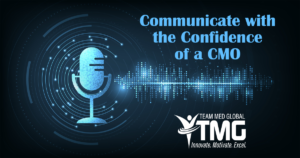 Imagine sitting across the table from your organization’s top executives, confidently presenting your insights and solutions with the poise and precision of a Chief Medical Officer (CMO). What if, in every meeting, your voice carried the same weight, your ideas commanded the same respect, and your presence inspired the same level of trust? For Medical Services Professionals (MSPs), mastering this level of communication can be the key to elevating your role from a behind-the-scenes contributor to a strategic leader. If you’re ready to transform the way you communicate and step into a more influential position, then it’s time to learn how to talk—and think—like a CMO.
Imagine sitting across the table from your organization’s top executives, confidently presenting your insights and solutions with the poise and precision of a Chief Medical Officer (CMO). What if, in every meeting, your voice carried the same weight, your ideas commanded the same respect, and your presence inspired the same level of trust? For Medical Services Professionals (MSPs), mastering this level of communication can be the key to elevating your role from a behind-the-scenes contributor to a strategic leader. If you’re ready to transform the way you communicate and step into a more influential position, then it’s time to learn how to talk—and think—like a CMO.
Why Communication Matters
At every level of an organization, communication shapes perceptions, builds relationships, and drives decisions. As an MSP, you often find yourself in the role of a bridge—connecting various departments, ensuring compliance, and facilitating essential processes. Your ability to articulate ideas, convey expectations, and influence decisions can mean the difference between seamless operations and avoidable setbacks.
Effective communication is not just about conveying information; it’s about inspiring confidence in others, whether you’re talking to a colleague, a healthcare provider, or a member of the C-suite. By adopting strategies that reflect the communication style of CMOs, you can enhance your influence, gain buy-in for your initiatives, and position yourself as a leader in your field.
Key Strategies for CMO-Level Communication
Clarity is King: CMOs value clarity above all else. When you communicate, be direct and concise. Avoid jargon or overly complex explanations, and get to the point quickly. Whether you’re writing an email or speaking in a meeting, focus on delivering a clear message that highlights the key takeaways.
Know Your Audience: Tailoring your message to your audience is critical. Before you communicate, consider who you’re speaking to and what they care about. CMOs are often focused on outcomes, efficiency, and strategic impact, so frame your message in a way that aligns with these priorities. Show how your ideas or actions will contribute to the organization’s goals.
Confidence Through Knowledge: Confidence in communication comes from a deep understanding of your subject matter. Take the time to thoroughly research and understand the topics you’re discussing. When you speak with authority, others are more likely to listen and take your ideas seriously.
Be Solution-Oriented: CMOs are problem solvers. When presenting an issue, don’t just highlight the problem—come prepared with potential solutions. Demonstrating that you have thought through the challenges and have actionable ideas shows that you’re proactive and capable of driving results.
Use Strategic Storytelling: Stories are powerful tools for making complex information relatable and memorable. When appropriate, use anecdotes or examples to illustrate your points. A well-told story can capture attention, make your message more persuasive, and leave a lasting impression.
Listen and Adapt: Effective communication is a two-way street. Cultivate the habit of active listening, which allows you to understand others’ perspectives and respond thoughtfully. Adapt your communication style based on the feedback you receive and the dynamics of the conversation.
Be Decisive: Ambiguity can undermine your message. When making recommendations or decisions, be decisive and confident in your stance. Even if you’re presenting multiple options, make it clear which course of action you support and why. This decisiveness is a hallmark of strong leadership and can inspire confidence in others.
Nonverbal Cues Matter: Your body language, tone of voice, and eye contact all contribute to how your message is received. Maintain open and confident body language, use a steady tone, and make eye contact to reinforce your message. These nonverbal cues can significantly enhance the perceived authority of your communication.
Building Your CMO Presence
Communicating like a CMO isn’t just about what you say; it’s also about how you say it. Developing this level of presence means cultivating the ability to project confidence, poise, and authority in any situation. This presence is built over time through practice and self-awareness.
Start by observing how the CMO in your organization communicates. What makes their messages impactful? How do they handle challenges and setbacks? Take note of their techniques and adapt them to your own style. Over time, you’ll find that these strategies become second nature, helping you navigate even the most challenging conversations with ease.
The Long-Term Impact
As an MSP, your role is integral to the success of your organization. By mastering the art of CMO-level communication, you not only enhance your own effectiveness but also contribute to the overall efficiency and cohesion of your team. This skill set is invaluable as you advance in your career, opening doors to new opportunities and leadership roles.
In the end, communicating with confidence and clarity is about more than just getting your point across—it’s about shaping the future of your organization and your professional journey. By focusing on these strategies, you’ll not only talk like a leader; you’ll become one.

